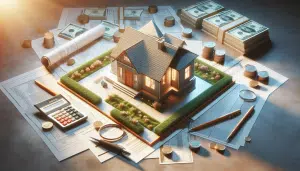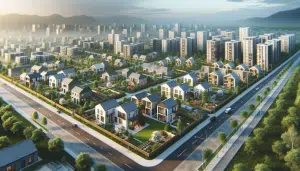Discover Hidden Factors That Affect Your Home Value
Isabella Lewis September 26, 2025
Curious what really drives your property value up or down? Explore how curb appeal, neighborhood trends, renovations, and even local zoning can play a role in your home’s worth. This guide unpacks the most surprising influences and offers insights to help homeowners and buyers make informed decisions.
The Unexpected Impact of Curb Appeal on Property Value
When people think of increasing their home value, they often overlook the significant influence of curb appeal. Visual appeal can set the tone for potential buyers before they even step inside. Well-maintained landscaping, fresh paint, and tidy walkways may seem cosmetic, but studies show these features substantially raise perceived and real property value. Sometimes, even minor changes like updating house numbers or planting shrubs makes a house more attractive to the local market and positively influences appraisals and offers (Source: https://www.nar.realtor/research-and-statistics).
It’s not just about first impressions; curb appeal communicates underlying care. Buyers may assume that if a home’s exterior is well-tended, its interior and infrastructure are too. This perception, while not always accurate, can boost demand and even speed up sales. Local real estate agents frequently note that homes with strong curb appeal linger less on the market, resulting in higher sale prices and more competitive offers from interested buyers.
Neighborhood aesthetics also matter. If nearby properties are well-maintained, that usually elevates the value of all homes on the block. Conversely, neglected exteriors or overgrown lots can have the opposite effect, potentially dragging values down. For anyone preparing to sell, investing in curb appeal improvements or organizing neighborhood cleanups can deliver a clear financial advantage. Even for current homeowners, maintaining curb appeal helps protect equity over the long run.
The Role of Local Market Trends in Home Valuation
Home value doesn’t exist in a vacuum; local housing market trends are critically important. Property appraisal is intrinsically linked to what others in the area are buying and selling for. When demand rises in a sought-after school district or an up-and-coming neighborhood, prices often follow suit. These external factors can change quickly based on employment rates, new infrastructure, and broader economic movements (Source: https://www.huduser.gov/portal/pdredge/pdr-edg-article-081320.html).
For buyers, understanding how neighborhood trends drive prices reveals opportunities and risks. Sometimes, a sudden influx of new businesses or a transportation project can kick off a wave of appreciation. Conversely, property values can stagnate or fall if the area loses major employers or faces new restrictions. Keeping an eye on local news and planned developments helps anticipate price shifts and informs smart real estate decisions.
It’s not only location—timing matters too. Homes listed during periods of low inventory in a hot market attract more buyers and better prices. Meanwhile, oversupply trends can tilt bargaining power to buyers. Local agents and official housing reports provide data on average listing durations, price changes, and emerging trends. Armed with this intelligence, both sellers and buyers can better position themselves for favorable transactions.
How Renovations and Upgrades Influence Home Worth
Upgrades are among the top strategies homeowners use to increase home value, but not all improvements guarantee a strong return on investment. Features like modern kitchens, energy-efficient windows, and additional bathrooms consistently top buyers’ wish lists and appraisal checklists. Even minor updates, like fixtures or fresh paint, can refresh an older space and raise its appeal and value among competing listings (Source: https://www.consumerfinance.gov/about-us/blog/renovating-your-home-which-projects-make-sense-for-you/).
However, it’s essential to consider local preferences. A popular renovation in one region might not yield the same value in another. For example, outdoor living spaces are highly prized in warmer climates, while basement conversions are valued in colder ones. Consulting recent sales and buyer surveys can ensure that upgrades align with neighborhood standards—preventing overimproving beyond what area buyers will pay for.
Smart renovations blend function with modern aesthetics and sustainability. Energy-efficient upgrades not only lower occupancy costs, but they may qualify homes for specific green certifications, increasing long-term appeal. Homeowners interested in significant improvements should document changes and keep receipts, as official records of upgrades help validate value increases during appraisals or future resale negotiations.
Neighborhood Amenities and School District Effects
Proximity to amenities such as parks, public transportation, shopping centers, and medical facilities can significantly influence home value. Ease of access to these resources is a frequent criterion for buyers and appraisers alike. In particular, walkable neighborhoods and those close to significant urban or economic centers tend to command higher prices (Source: https://www.brookings.edu/articles/the-amenity-value-of-urban-parks/).
Perhaps even more critical, especially for families, is the local school district’s quality rating. There is extensive evidence that homes in high-performing school zones consistently sell for a premium over comparable properties elsewhere. School rating changes can directly ripple through area home values, sometimes outpacing even broader market shifts. Many buyers set their searches by school district, highlighting the outsize impact this factor holds.
Other neighborhood features—like low crime rates and community engagement—impact value as well. Secure, socially active communities build trust and stability, which raises area desirability. Homeowners often participate in or support local activities, recognizing that these collective efforts bolster property values both individually and across the neighborhood.
Zoning, Regulations, and Restrictive Covenants
Zoning laws, homeowner association rules, and local regulations are sometimes underestimated in their power to affect property value. Zoning establishes what activities or developments are permissible on a lot, which can limit or enhance value. For example, a residential property rezoned commercial may experience a jump in price if it opens up higher-value uses (Source: https://www.planning.org/homeownership/zoning/).
On the flip side, restrictive covenants—rules set by homeowners associations or deed restrictions—may limit owners’ ability to alter their property. While these agreements preserve a neighborhood’s character and protect overall value, they can also frustrate those wanting to expand or renovate beyond the set guidelines. It’s important to understand any existing regulations before investing in upgrades or changes that might conflict with these rules.
For buyers, checking the property’s zoning and any regulatory overlays prior to purchase is essential to avoid unexpected issues. Even seemingly minor limitations, such as tree preservation ordinances or rules on driveway expansions, can have ripple effects on value now and in the future. Access to accurate public records and professional legal or planning guidance can help navigate this maze of regulations with confidence.
Environmental Factors and Disaster Preparedness
Climate and environmental risk are emerging as key influences on home value. Flood plains, wildfire exposure, air quality, and noise pollution all shape buyer perception and insurance premiums. Recent events have put more focus on disaster preparedness, with buyers considering how properties could withstand natural disruptions (Source: https://www.fema.gov/emergency-managers/risk-management/building-science/natural-hazards).
Eco-friendly features, such as solar panels, energy-efficient appliances, and sustainable landscaping not only cut costs over time but also appeal to an eco-conscious buyer segment. As cities adapt to changing environmental realities, properties equipped for contingencies—like elevated foundations in flood-prone zones or fire-resistant materials in high-risk areas—often command premiums over their less-prepared counterparts.
Insurance accessibility and cost also shape value. Homes in designated high-risk areas may face steep insurance premiums or even coverage restrictions. Buyers and owners can consult public hazard maps and local municipal data to better understand their property’s risk profile. Investing in resilience can protect value and ensure a smoother sale or move when the time comes.
References
1. National Association of Realtors. (n.d.). Research & Statistics. Retrieved from https://www.nar.realtor/research-and-statistics
2. U.S. Department of Housing and Urban Development. (n.d.). Local Market Trends. Retrieved from https://www.huduser.gov/portal/pdredge/pdr-edg-article-081320.html
3. Consumer Financial Protection Bureau. (n.d.). Renovating Your Home: Which Projects Make Sense for You? Retrieved from https://www.consumerfinance.gov/about-us/blog/renovating-your-home-which-projects-make-sense-for-you/
4. Brookings Institution. (n.d.). The Amenity Value of Urban Parks. Retrieved from https://www.brookings.edu/articles/the-amenity-value-of-urban-parks/
5. American Planning Association. (n.d.). Zoning and Land Use Controls. Retrieved from https://www.planning.org/homeownership/zoning/
6. Federal Emergency Management Agency. (n.d.). Natural Hazards and Building Science. Retrieved from https://www.fema.gov/emergency-managers/risk-management/building-science/natural-hazards







